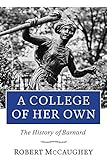A College of Her Own : The History of Barnard / Robert McCaughey.
Material type: TextSeries: ColumbianaPublisher: New York, NY : Columbia University Press, [2020]Copyright date: ©2019Description: 1 online resource : 44 b&w photographsContent type:
TextSeries: ColumbianaPublisher: New York, NY : Columbia University Press, [2020]Copyright date: ©2019Description: 1 online resource : 44 b&w photographsContent type: - 9780231552004
- 378.747/1 23
- LD7033 .M34 2020
- LD7033 .M34 2020
- online - DeGruyter
| Item type | Current library | Call number | URL | Status | Notes | Barcode | |
|---|---|---|---|---|---|---|---|
 eBook
eBook
|
Biblioteca "Angelicum" Pont. Univ. S.Tommaso d'Aquino Nuvola online | online - DeGruyter (Browse shelf(Opens below)) | Online access | Not for loan (Accesso limitato) | Accesso per gli utenti autorizzati / Access for authorized users | (dgr)9780231552004 |
Browsing Biblioteca "Angelicum" Pont. Univ. S.Tommaso d'Aquino shelves, Shelving location: Nuvola online Close shelf browser (Hides shelf browser)

|

|

|

|

|

|

|
||
| online - DeGruyter Lineages of the Literary : Tibetan Buddhist Polymaths of Socialist China / | online - DeGruyter The Fury Archives : Female Citizenship, Human Rights, and the International Avant-Gardes / | online - DeGruyter The Perilous Public Square : Structural Threats to Free Expression Today / | online - DeGruyter A College of Her Own : The History of Barnard / | online - DeGruyter Foucault's Strange Eros / | online - DeGruyter Take Back What the Devil Stole : An African American Prophet's Encounters in the Spirit World / | online - DeGruyter Wisdom as a Way of Life : Theravāda Buddhism Reimagined / |
Frontmatter -- CONTENTS -- Preface -- Acknowledgments -- 1. “WHAT’S A NEW YORK GIRL TO DO?” -- 2. EAST SIDE, WEST SIDE: A TALE OF TWO CITIES -- 3. BECOMING BARNARD: A PLACE IN THE CITY -- 4. WHO’S AFRAID OF VIRGINIA GILDERSLEEVE? -- 5. GOOD TIMES: BARNARD IN THE TWENTIES -- 6. TOUGH TIMES: DEPRESSION, WAR, AND OTHER DISTRACTIONS -- 7. AGAINST NOSTALGIA: THE McINTOSH ERA -- 8. INTO THE STORM -- 9. SAYING NO TO ZEUS -- 10. BARNARD RISING -- 11. “NEW YORK, NEW YORK” -- 12. GOING GLOBAL -- Notes -- Selected Bibliography -- Index
restricted access online access with authorization star
http://purl.org/coar/access_right/c_16ec
In 1889, Annie Nathan Meyer, still in her early twenties, led the effort to start Barnard College after Columbia College refused to admit women. Named after a former Columbia president, Frederick Barnard, who had advocated for Columbia to become coeducational, Barnard, despite many ups and downs, became one of the leading women’s colleges in the United States.A College of Her Own offers a comprehensive and lively narrative of Barnard from its beginnings to the present day. Through the stories of presidents and leading figures as well as students and faculty, Robert McCaughey recounts Barnard’s history and how its development was shaped by its complicated relationship to Columbia University and its New York City location. McCaughey considers how the student composition of Barnard and its urban setting distinguished it from other Seven Sisters colleges, tracing debates around class, ethnicity, and admissions policies. Turning to the postwar era, A College of Her Own discusses how Barnard benefited from the boom in higher education after years of a precarious economic situation. Beyond the decisions made at the top, McCaughey examines the experience of Barnard students, including the tumult and aftereffects of 1968 and the impact of the feminist movement. The concluding section looks at present-day Barnard, the shifts in its student body, and its efforts to be a global institution. Informed by McCaughey’s five decades as a Barnard faculty member and administrator, A College of Her Own is a compelling history of a remarkable institution.
Mode of access: Internet via World Wide Web.
In English.
Description based on online resource; title from PDF title page (publisher's Web site, viewed 02. Mrz 2022)


